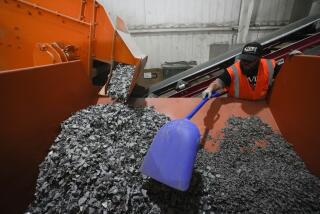From Energy Plant Waste Mighty Tomatoes Grow
- Share via
FORT LUPTON, Colo. — An experiment in saving energy has blossomed into a greenhouse that uses waste heat from electric power plants to produce 250 tons of perfectly ripe, unblemished tomatoes every week.
“Consumers for years have complained that [winter] tomatoes taste like the box they come in and that they are as hard as billiard balls,” said Bud Bridgwater, marketing director for Colorado Greenhouse LLC in Fort Lupton. “We’ve put an end to that.”
“It’s a better tasting and smelling tomato,” said Kent Beesley, a produce buyer for City Market grocery stores in Grand Junction. “Once you get them home, you can leave them on your counter and they will hold up for one to two weeks.”
On the plains 30 miles northeast of Denver, a 272-megawatt, natural gas-fired power plant provides electricity to neighboring communities. The heat generated by its turbines is pumped next door into a vast configuration of galvanized steel and white, tempered glass.
This 20-acre building is part of what is fast becoming known as the largest hydroponic tomato producer in North America.
Inside, rows of tomato vines grow up to 30 feet long. Their roots are anchored in special rocks, fed by tiny irrigation tubes. Few pesticides are used.
Bumblebees buzzing about the operation pollinate blossoms naturally. Tiny wasps and other insects stand guard against tomato pests.
Because greenhouse tomatoes aren’t stockpiled, they can be bred with extra-thin skins and meatier insides. They are brought to market within three to five days of harvest.
The owners, in the 1980s, were more interested in generating electricity than in growing tomatoes. Boulder-based Colorado Venture Management Inc., one of the primary investors, organized investor groups to build private power plants that would sell power to Public Service Co. of Colorado.
To meet efficiency standards, they used a process called cogeneration, which harnesses heat created by generator turbines for other commercial uses. One of the cheapest conceivable uses was to heat greenhouses.
But now the tables in this investment scheme have turned. Today, Colorado Greenhouse promises to be more profitable than the power plants that spawned it, said Bill Coleman, chairman of Colorado Venture Management.
More to Read
Inside the business of entertainment
The Wide Shot brings you news, analysis and insights on everything from streaming wars to production — and what it all means for the future.
You may occasionally receive promotional content from the Los Angeles Times.









